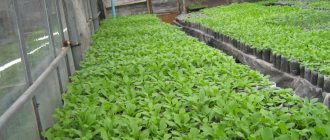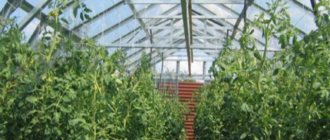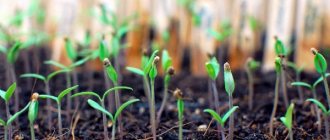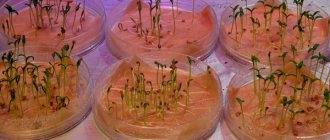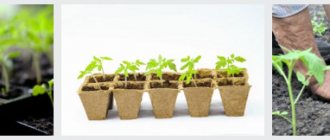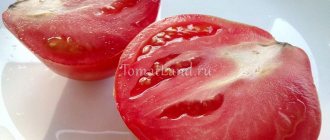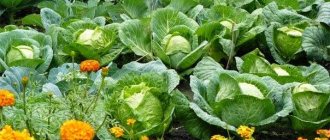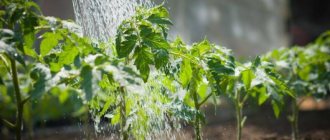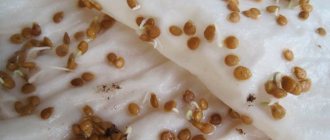What determines seed germination?
The germination of tomato seeds depends on many factors, but for the most part, it all depends on the person himself. Of course, you should never discount the fact that the grains or soil may be of poor quality. Then no manipulation will help the seeds sprout faster.
IMPORTANT! On average, tomato grains germinate within 5-7 days. Whether this period increases or decreases depends on a number of factors.
Among the main factors, ceteris paribus, influencing the rate of germination of tomato grains, the following can be noted:
- Pre-planting processing of seed material;
- Tomato variety;
- Air temperature;
- Lighting;
- Air humidity;
- Quality of seed material.
How long does it take for untreated tomato seeds to germinate?
If you collected tomato seeds yourself, took them from neighbors, or sow cheap purchased seeds, then you will have to wait 1.5 - 2 weeks for germination.
The fact is that tomato grains are covered with a fairly dense and hard outer shell; in order for sprouts to appear, this shell must be broken through. In addition, the grain contains special essential oils that inhibit the germination of sprouts. This is a natural containment mechanism.
ON A NOTE. Of course, even untreated seeds can germinate earlier. But this is rather luck and coincidence.
How long does it take for treated seeds to germinate?
Seed treatment can be of two types:
- Factory. When all the necessary procedures for preparing for sowing are carried out by the manufacturer himself;
- Homemade. When the summer resident prepares for planting grain. Usually the procedure takes place in the form of soaking in a solution of the active substance.
Moreover, if the seed material has been processed at the factory, then there is no need to carry out an additional soaking procedure.
Properly prepared planting material will produce the first shoots 5-7 days after sowing. And “fresh” and strong grains can germinate as early as 4 days.
NOTE! Data are given for seeds of the same quality. It may well happen that untreated “fresh” seeds will sprout faster than processed ones that have lain in your box for several years.
Rules for soaking seeds before sowing
Before you start soaking, you should soak the tomato seeds in a salty solution. It is prepared as follows: 15 g of salt is dissolved in 500 ml of water. Leave the grains in the resulting mixture for 5-10 minutes, then drain the liquid along with the floating seeds. Dry the remaining grains.
Now you need to prepare the container for subsequent soaking. A saucer, small jar or cup will do. The selected container should be scalded with hot water. Tomato grains are laid out on a damp cotton cloth and placed over the entire surface of the container so that when pecked they do not interfere with each other. When subsequently moistening the fabric, it is important not to fill it with water, but only to saturate it with moisture, draining the excess liquid.
Rules for soaking seeds before sowing
When the grains are laid out, the container should be hermetically sealed with a plastic bag or lid, making something like a greenhouse. Send the container to a warm and dark place. The grains must be checked daily and ventilated briefly. When the roots appear, the container must be placed on a lighted windowsill. Hatched and strong seeds should be planted in seedling pots or cups with prepared soil.
How does germination differ depending on the variety?
Another factor that can influence the timing of the appearance of the first tomato sprouts is the variety. There are three large groups of tomatoes depending on the period of fruiting - early ripening (early), mid ripening, late ripening (late).
These varieties differ not only in the speed of appearance and ripening of fruits, but also in the speed of the main biological processes inside the plants. Late tomatoes develop a little slower. And this also applies to the timing of the appearance of sprouts.
Of course, with full pre-sowing preparation, the germination time of late varieties can be accelerated, but under equal conditions they will sprout a couple of days later.
BY THE WAY. That is why it is recommended to sow different varieties in different containers, so that seedlings appear at the same time, and all procedures can be carried out on all plants at once, rather than choosing one specimen at a time.
Read about the best varieties of tomatoes in our article “Varieties of Tomatoes”.
How to increase germination
By increasing germination we mean stimulating germination, seedlings appear faster. There are ways to awaken even old seeds that do not germinate under normal conditions.
The “Living and Dead Water” method for old seeds:
- Pour the seeds onto a cloth, tie its edges with thread to make a bag on a string.
- Alternately immerse the seeds either in hot (80 °C) or in ice water, for example, spring water or plain water with ice cubes. Hold the bag in each vessel for no longer than 5 seconds, then remove it, squeeze out the water and put it in another.
- Repeat 5 times, finish with cold water.
Dip the bag of seeds alternately into vessels with hot and cold water.
Recipes for different solutions to accelerate seed germination:
- Epin - 2 drops per 100 ml of water.
- Energen Aqua - 1 ml or 9 drops per 50 ml of water.
- Sodium humate - 0.5 g per 1 liter of water.
- Bud - 2 g per 2 liters of water.
- Wood ash - 3 tbsp. l. Stir in a liter of water, leave for a day, strain.
- Aloe juice in its pure form is for expired seeds, but for regular seeds it can be diluted with water 1:1.
Keep the seeds in any solution from 1 to 18 hours. The older they are, the longer the treatment with the stimulant should be. However, you cannot leave seeds in water for a day or more! There is a supply of air under the seed coat, which is gradually consumed and the embryo dies.
Video: vitamin cocktail to increase germination
How does temperature affect the similarity of tomato seeds?
Plants love warmth. And tomatoes are no exception. In order for seeds planted in the ground to grow, they need to be provided with a sufficiently high temperature.
The fewer degrees the thermometer shows, the slower the grains germinate. The same goes for temperature changes. They negatively affect the rate of emergence of seedlings.
In an ordinary apartment with central heating, it is quite problematic to regulate the desired temperature level.
But, if you have such an opportunity, then provide the crops with a temperature of 25 degrees. This is the optimal mode for the fastest germination of tomato grains. And the greatest effect will be if you create a greenhouse effect for the crops. This is very easy to do; you just need to cover the container with the planted grains with cling film or a plastic bag.
ON A NOTE. In an ordinary apartment, the best place for sowing tomatoes that have not yet sprouted is under the radiator. But we must not forget to maintain the required level of humidity in the greenhouse.
How does the quality of seed material affect
In fact, the quality of the seed is the decisive factor. If the grains you are going to plant are expired or of poor quality, then nothing you do will help them sprout faster. On the other hand, healthy and genetically strong grains will germinate even under the most unfavorable conditions.
Unfortunately, the quality of purchased seeds cannot be guaranteed. There is always a chance to buy dummies, “dormant” grains, etc. But a number of simple rules will help minimize the chance of buying low-quality seeds:
- Buy only proven seed material from reliable manufacturers. This way there is less chance of running into counterfeit products.
- Do not store seeds in the refrigerator. So you only drive them into hibernation.
- Do not buy seeds that have expired. Seed storage duration is 5 years. In rare cases, there are varieties that can retain their properties for up to a decade and a half, but this is usually written on the packaging. If there are no such notes, then the variety is standard with a standard shelf life.
ON A NOTE. That is why do not try to buy seeds for future use. Take as many packages as you can sow. Every year the germination of the material gets worse and worse. In addition, new varieties and hybrids with improved characteristics appear every year.
Seedlings grown from high-quality seed material tolerate picking and transplanting better and produce a better harvest.
How quickly do tomato seeds germinate?
Reading time: 7 minutes
Experienced gardeners know that getting a rich tomato harvest requires a lot of work. One of the most important stages is the preparation of seed material. It is necessary to know how many days will it take for the tomato seeds to sprout, because the timing of the emergence of seedlings determines the moment of planting the seedlings in the ground and the further actions of the gardeners. As a result, the harvest itself is based on this indicator.
Data on germination and germination times
Seed germination is largely determined by the variety and type of tomato. If you know the tomato variety, its characteristics and the recommended date for planting the seeds, you can accurately determine when the shoots will appear. The error is a couple of days. Seeds of varietal tomatoes usually have a standard germination period, depending on planting conditions. When planted in the ground, the first seedlings germinate 10 days from the moment of planting. But by creating optimal air-thermal conditions, this period can be shortened.
Pre-processed
To preserve seeds, producers treat them with complex mineral fertilizers. In appearance they resemble dragees or granules. This is done to increase germination. However, before placing the seed in such a shell, it is dried. This is worth remembering before boarding. For good germination, the processed raw materials must be soaked in order to bring the humidity to the normal level established by nature. If this is not done, germination may be reduced to zero or sprouts will appear several days later than expected.
Raw
An ordinary, untreated seed should begin to grow immediately after planting in the ground. The speed of germination is affected by humidity, tomato variety, soil structure, the presence of minerals and trace elements necessary for life, and permeability to air and water. When creating optimal conditions for sowing tomatoes, seedlings appear much faster.
What does the date depend on?
Seed germination depends on many factors. This includes the plant variety, the condition of the seed, temperature, density and saturation of the soil with useful minerals, and illumination.
The date of appearance of the first shoots depends on the following conditions:
Climatic conditions and temperature conditions
The optimal temperature for germination is 21 degrees Celsius. At low temperatures, the time for embryos to hatch increases, since the growth of seedlings stops until better times arrive.
Seed variety and quality
When choosing purchased seeds, you should make sure that they are of the highest quality. You need to look at the packaging for the region for which the tomatoes are intended. The yield and timing of fruit ripening depend on this. Choose the variety of tomatoes that suits the specific climate zone.
Over time, seeds lose their ability to germinate. Harvested and dried last year will germinate in 4 days. Those that were dried 3 years ago germinate on average within a week. Very dry raw materials germinate in 10 days. Small, dry material is most often non-viable, and its chances of germinating are minimal.
Pelleting
For full development, the seeds are treated with fertilizers. But this method slows down their pecking.
How to prepare seed material and speed up seedling germination
Seed material must be prepared in advance. The seeds are carefully discarded, leaving only viable ones. This ensures good germination, quality of seedlings and high yield of tomatoes.
Seeds must be selected in accordance with the climatic zone in which the tomatoes will be ripened. Varieties intended for the southern regions will not be able to ripen in time in the conditions of the central regions. In order for tomatoes to germinate quickly, bloom on time, and bear good fruit, you need to study all the information on the packaging.
- fruit ripening conditions;
- suitability of the variety to the climate;
- shelf life of seed material.
Checking the expiration date
The suitability of the seeds can be found on the packaging. Despite the fact that their viability remains for several years, fresh ones (harvested a year ago) sprout faster than four-year-old ones. Most varietal tomato seed is stored for 5 years. But there are specimens with a long shelf life (up to 10–15 years), while almost 100% remain viable. Information is indicated on the packaging. If such information is missing, then it is standard.
Rejection of unsuitable seeds
Experienced gardeners advise checking the quality of seeds with a saline solution before planting. To do this, dissolve a teaspoon of table salt in a glass of water. Place the seeds there and leave for 10 minutes. Viable specimens will fall to the bottom, and “dummies” will float to the surface. You can check the germination of seeds by germinating them on a damp cloth. In this case, you can definitely be sure of their viability; sprouts will hatch from the good ones.
Soaking in special compounds
Before planting, the seeds should be soaked for no more than a day in clean water or a weak solution of potassium permanganate. This will help the embryo “wake up”, and treatment with potassium permanganate will additionally disinfect it. When soaking, plant growth stimulants such as Energen and Immunocytophyte are added to the water. You can use plain water at room temperature or potato juice. A fabric bag with seed material is placed in the liquid and waited for it to swell for 12 hours. You shouldn’t keep the seeds in water any longer, they will suffocate.
Hardening
Tested, healthy tomato seed material is placed in a cold place for a day, where the temperature ranges from +1 to -30 degrees Celsius. Then they are transferred to a room with a temperature of +15 to +18 degrees and kept there for another 6 hours.
Treatment with disinfectants
Disinfection (dressing) of tomato seeds is a procedure necessary to destroy bacteria located under the seed coat. For disinfection, a time-tested method is used - treatment with a one percent solution of potassium permanganate for 20 minutes. You can replace potassium permanganate with a two percent solution of hydrogen peroxide, heated to 45 degrees. The seeds are kept in it for 5 minutes. After pickling, they are washed and dried.
Soaking seeds in a solution of potassium permanganate
Using an aquarium compressor
Another way to awaken the embryos. The seeds are placed in a half-full glass of water and the compressor tube is placed there. A running aquarium compressor saturates the seeds with oxygen. The procedure takes 12 hours.
If the conditions for preparing the seed are met, good humidity, temperature, and soil composition are ensured, then seedlings should appear according to the dates indicated on the packaging.
How to speed up germination?
Despite the fact that, by and large, the germination of tomato seeds is determined by the characteristics of the variety and external factors, summer residents have become adept at influencing the rate of seed germination.
To do this, they use several procedures, the essence of which is to influence the seeds in a certain way (with a drug or a physical process).
Do I need to stratify tomato seeds?
In general, tomatoes do not need stratification. Soaking is enough. But, if you still decide to carry out this procedure, then use the cold stratification method.
What is bubbling, or why do tomato seeds need an aquarium compressor?
Bubbling is a way to “wake up” the seeds and treat them before planting. For the procedure, you will need an aquarium compressor that will saturate the water with the seeds with air. As a result, the outer shell will soften.
The disadvantage of this method, in addition to the need for a compressor, is the time it takes. Bubbling should be carried out at intervals of 16 hours.
How to soak tomatoes?
Soaking tomatoes is very easy. You will need a shallow container, gauze (cotton pads) and a soaking solution. The seeds are placed inside a gauze “envelope” and soaked in a solution of the active drug. After which the grains are left for a day, moistening the rag every 4 hours.
After 24 hours, the seeds are washed, dried and planted.
More information about soaking seeds is presented in our article “Soaking seeds before planting, how to soak correctly.”
How to choose only high-quality tomato seeds and reject bad material?
The simplest method is to sort using a saline solution.
- Pour a teaspoon of salt into a cup of water and stir thoroughly.
- Pour the seeds into a cup and wait 10 minutes.
- Floating grains can be thrown into the trash with a clear conscience. But those that have sunk to the bottom must be washed and sent for the soaking procedure.
How does shelf life affect germination?
As already mentioned, every year the seeds fall deeper into hibernation and become more difficult to germinate. It is much more effective to use seeds purchased immediately before planting.
What is panning
Pelleting is the coating of grains with a special nutrient mixture to accelerate germination, disinfection and stimulate the growth of seedlings.
The nutrient mixture includes peat, mineral components, humus, fungicides and an adhesive that attaches this entire mass to the seed.
Seeds are pelleted mainly in factories, although experienced summer residents carry out the procedure at home.
IMPORTANT! There is no need to soak coated seeds!
Seed treatment before sowing
Important clarification. Seed material must be processed immediately before sowing. This means that you must plant immediately after completing the soaking procedure (bubbling, stratification, disinfection, etc.).
The only thing is that it is better to dry the seeds before sowing. But this will take no more than half an hour. That is, you need to plan all procedures in such a way that, having completed one, you immediately begin to carry out another. There is no need to leave the seeds lying around for half a day to no avail.
Accelerating tomato germination
Many vegetable growers want their seedlings to germinate very quickly. In order for tomato seedlings to grow faster, you need to plant the seeds correctly.
Checking the expiration date
The expiration date is checked to find out how long after purchase the seeds cannot be used. Their optimal shelf life is about five years. However, there are some varieties that can be used after 15 years from the date of purchase. For planting, it is recommended to use non-expired planting material.
Weeding out bad seeds
It is imperative to get rid of bad planting material, since it is impossible to determine how long it takes for seeds that were not pre-selected for planting to germinate. To sift out non-germinating seeds, the seed is placed in a glass filled with saline solution. The seed is kept in the liquid for about 20 minutes. During this time, seeds that will not germinate well will rise to the surface.
Soak
To improve the germination of tomato seeds, a technique is used, the essence of which is to soak the tomatoes in a special nutrient solution. To do this, you can use store-bought products or prepare everything yourself. Experienced gardeners most often use the second option, as it is more economical. So, how long to soak the seeds and what needs to be done for this?
The seeds are placed in a small cloth bag and placed in heated water. The soaking time is about 10-15 hours. If during this period of time the water changes color, it needs to be replaced.
It is not recommended to soak the seeds for too long as they may spoil.
Hardening
In order for tomatoes to germinate quickly and develop better in the future, it is necessary to harden them in advance. To do this, the seeds are laid out between several layers of fabric and placed at the bottom of the refrigerator. They put them there at night and take them out only in the morning. This procedure should be carried out 2-3 times.
Disinfection
You can also speed up the germination time of planting material using preliminary disinfection. This can be done using an aqueous solution of potassium permanganate, in which the seeds must be kept for about half an hour. To do this, they are placed in gauze and lowered into a container with a solution. After disinfection is completed, they should be rinsed with cool water.
Germination
In order for the tomato to sprout faster, its seeds must be placed on a damp cloth. This should be done in a warm room with a temperature of at least 25 degrees. When germination, you need to very carefully monitor the condition of the tissue. It needs to be moistened regularly so that it does not dry out completely.
Sprouted seeds need careful care. If germinated seeds are handled roughly, their roots may be damaged. Therefore, during cultivation, it is recommended to use thick gauze to protect the seed from damage.
At what depth should I plant tomato seeds?
Planting depth can adjust the timing of seedling emergence.
There is no need to plant tomato seeds too deep. On average, 1.5 cm will be enough. And very small grains can generally only be lightly sprinkled with earth mixed with sifted sand.
REFERENCE. The quality of the soil is no less important. Buy light and nutritious soil for tomato seedlings or use peat tablets. On heavy soils, seeds germinate less easily. It is not recommended to use “undiluted” garden soil for germination.
Why don't tomatoes sprout?
If something went wrong, the tomatoes did not germinate, then you need to look for the reason. Sometimes “long” is an abstract concept, especially if the seeds are old or one of the important conditions is not met - humidity, soil composition, temperature, immersion depth and others. How long it takes for a seed to germinate depends on its viability, the availability of nutrients, and the variety of tomato.
Seed infection
Sick, infected seeds take longer to germinate, developing into weak plants. Therefore, at the preliminary stage of preparation, sorting and treatment with potassium permanganate or hydrogen peroxide are used.
Dense soil
A thick cover of the soil mixture, which hinders growth, is another reason for slower germination. This can be avoided by thoroughly grinding the soil before planting.
Sowing too deep
An old gardener's rule is that the sowing depth is equal to three times the size of the seed. Sometimes this happens by accident if watering occurs not before planting (as all sources and experts recommend), but after.
Low temperature
Violation of the temperature regime also leads to deviations from the germination dates. If this indicator is close to 10 degrees, the seed may not sprout at all. Therefore, lowering the temperature below plus 12 is not recommended.
How to plant seeds correctly
Tomatoes should be sown in light nutrient soil. The planting container must be provided with a drainage system.
The seeds are placed at a distance of several centimeters from each other. There is no need to plant deep. Holes 1.5 cm deep are enough. After sowing, you need to carefully water it, cover the container with polyethylene or glass and place it in a warm place until shoots appear.
Read more about different methods of planting tomatoes and caring for seedlings in our article “Planting tomatoes for seedlings, growing tomatoes at home.”
How to influence the germination rate of tomatoes
Sometimes the germination period of tomato seeds takes quite a long time, which is why you want to hurry up their germination. In such cases, soaking in various solutions helps:
- In growth stimulant. This is the most popular and logical way to speed up the germination time of tomato grains. For these purposes, Zircon, Epin Extra, aspartic or succinic acid, gibberellin, Novosil, etc. are used.
- In natural nutritional mixtures. Aloe juice: water and aloe juice are combined in a 1:1 ratio, the resulting solution is poured into a non-metallic container, the grains are placed there and soaked for a day.
- Honey: a solution is made from one glass of water and 1 tsp. honey, the grains are soaked in it for 24 hours.
- In cooling water. The seeds are placed in a canvas bag and filled with hot water. When the water has cooled, the procedure is repeated. In total, it needs to be repeated 4-5 times a day.
Germination period of tomato seeds
An equally effective way to speed up the germination time of tomato seeds after sowing seedlings is to germinate them on a battery.
To do this, tomato grains are laid out on a damp cloth or sponge, placed in a plate or other shallow container, covered with a damp cloth, wrapped in cling film and sent to a warm place (in this case, near the radiator). After a few days, the grains will hatch, but provided that the temperature does not exceed +28 ° C, and the substrate always remains moist.
How to choose the right landing time
Tomatoes should be planted on the waxing moon. This time is considered the most successful for the procedure. It is not recommended to plant on a dying moon, but, as a last resort, you can sow on these days. But you can’t sow tomatoes on the full moon or new moon.
Read about when to plant seeds according to the lunar calendar in our article “Lunar sowing calendar for gardeners and gardeners for 2020.”
Features of sowing in open ground
Sowing directly into open ground is not much different from sowing seedlings. But there are still some nuances:
First , you need to prepare the ground. In early spring, the soil is fertilized with organic matter. Moreover, this must be done almost immediately after the snow melts. You also need to remember to loosen the soil.
Secondly , immediately before planting, the soil must be disinfected. It is best to use a solution based on Fitosporin-M.
Thirdly , planting takes place in the second half of May. There is no point in planting seeds earlier; they will still not sprout before the soil warms up.
Fourthly , after germination until fruit set, seedlings should be covered overnight with spunbond or halves of plastic bottles.
ON A NOTE. When sowing tomatoes directly into the ground, germination should take a little longer than usual.
Preparing the seeds
In the early stages of ensuring that tomatoes are ready for harvest, seed material must be prepared. It must be viable, of high quality, with good germination. To avoid typical mistakes of novice gardeners, just use the algorithm given below.
What you need to know about choosing seeds
Seed of seed is different. This applies to the variety (early, medium, late), compliance with the region, shelf life, size. Tomatoes for the southern regions may not grow in the conditions of the Urals, and greenhouse tomatoes will not grow well in open ground. Therefore, first they carefully study the “pedigree” of the tomato: fruiting conditions, compliance of this variety with the proposed climatic conditions, shelf life.
Seeds obtained from random sources will give an unpredictable result: from zero to infinity. The same applies to seed that is too old. In general, you shouldn’t skimp on the quality of the seed.
Checking the expiration date
Seed shelf life (ability to germinate) is several years. But at the same time, one-year-old ones germinate better than three-year-old ones. It is easy to check this indicator: the data is always indicated on the packaging.
Difference between good and bad seed
To the uninitiated, it seems that all seeds are the same. Whatever the case. The good ones will certainly sprout, and the bad ones will most likely turn out to be dummies. They differ in appearance – in size, shape, color. It is easy to check the germination of a seed even at home, without special equipment.
How to check the germination of tomato seeds
Products from well-known manufacturers do not need advertising or testing: out of two dozen seeds, at most one or two will not sprout. These are high figures. But what to do if the germination of seeds is in doubt (unknown)?
See also
Description of the best varieties of Lyubov Myazina's signature tomatoes, cultivation
Read
The simplest test involving immersion in a weak saline solution will give a definite answer. Heavy and healthy seeds will sink to the bottom, and empty ones will appear on the surface. You can do the same using potassium permanganate. If there is nothing at hand at all, throw the seeds into clean water and after 20 minutes the result is summed up.
The longest method is based on germination: the seeds are placed on a clean cloth or cotton pads. And then, after the fact, germination is determined.
Answers to frequently asked questions
Do I need to soak the seeds before planting?
No, but this procedure will have a positive effect on the time of emergence of seedlings. It is generally contraindicated to soak coated seeds! The liquid will destroy the entire layer that covers such grains.
Can I use old seeds?
Try it, but be sure to soak them in a solution of hydrogen peroxide and follow the technology for planting and caring for crops.
How long will it take for the sprouts to appear?
Properly sown tomato seeds germinate within 5-7 days, plus or minus a couple of days.
How deep to plant seeds?
Don't bury the seeds too deeply. 1.5 cm is the optimal depth.
What to do with coated seeds?
Just sow them as seedlings. This material has already undergone pre-sowing preparation.
Sprouts have appeared, what to do?
Move the seedlings to a slightly cooler but bright place for 3-4 days until all seedlings appear. Then the containers with seedlings can be placed in a permanent place.
How many days does it take for tomato seedlings to sprout?
Seedlings on the windowsill. Even at the end of winter, our grandmothers filled all the window sills with trays of soil for seedlings. This is not surprising; seedlings grown with your own hands are much better than purchased ones. Not because the store-bought variety is worse, tomatoes from seed get used to the same soil, to the same way of caring for the plant, even to the same water.
You can buy soil for seedlings in a specialized store; they sell peat cups or special cassettes for seedlings. The advantage of purchased soil is that it comes with all the minerals and fertilizers, but the disadvantage is that the soil in the garden, even with added fertilizers and minerals, is not so ideal; the plants may get sick after changing the soil.
Often, soil is collected into a container from the garden in the fall before frost, when all the fertilizer has been applied. Seeds ready for planting are planted in it. This is how tomatoes from seeds get used to the same growing conditions.
It is better to place seedlings on a window on the south side while protecting the soil from direct sunlight. Warmed soil will quickly sprout. Within 3-4 days, the planting material begins to grow. After the sprouts appear, move the pots with tomatoes to a place with a lower temperature by 2-5 degrees, so that the roots do not stretch, but begin to grow and strengthen.
It is very simple to organize watering of seedlings on a window; the water must be settled or you can add a spoonful of hydrogen peroxide to the water (the chemical elements of water diluted with peroxide are similar to rainwater).
Seedlings in a greenhouse
A greenhouse is an ideal place for growing tomatoes and growing healthy and strong seedlings. Work in greenhouses begins much earlier than in open ground. With the first glimpses of the sun, the doors and windows of the greenhouse (which were open for the winter) are closed so that the earth warms up faster. If the greenhouse is heated, then it is possible to grow tomatoes all year round.
After just a few days in the greenhouse, work begins on preparing the soil. Due to the fact that the greenhouse is opened for the winter, the greenhouse is covered with snow, an excellent way to saturate the ground with melt water. The gardener himself decides what is best to remove the remaining grass from last season, treat the soil (loose or dig).
Today, there is a statement that the soil can simply be loosened without digging, so as not to disturb the soil structure. Only in the greenhouse the temperature will be stable at + 160C; it is possible to plant the hatched seeds in the ground.
As a rule, the timing of planting seeds in greenhouses or greenhouses is indicated on the packaging. It is recommended to sow tomatoes in the month of April, when the temperature is stable and growing during the day, without significant frosts at night, there are exceptions.
The depth of the furrow is 3-5 cm, the distance between the rows is 15 cm. Before sowing, the furrows are well watered. Here, at the request of the gardener, who uses settled water and who takes it from the tap.
The planted seeds are covered with sand or peat, usually with the same soil. After planting, water it approximately on the third day, or later if there was a lot of water during planting. Seeds begin to germinate on days 7-10 if the temperature remains stable.
It is advisable to feed the field where seeds grow and seedlings with microelements. After the tomatoes have thrown out the third leaf, it is advisable to refresh the soil and add the top ball. This will provide new nutrients and strengthen the root.
Seedlings need to be hardened off periodically; to do this, the greenhouse is opened for ventilation. The first time for a few minutes, each subsequent time the time is increased.
Planting seeds in open ground
If the area of land in the garden does not allow you to allocate an area for a greenhouse or greenhouse, the seeds for seedlings are planted in the ground. The period for planting the material in the ground is approximately the end of April and May. Around this period, warm weather sets in and at night the thermometer does not drop below + 15-160C. Seedlings feel quite comfortable in the garden.
After the winter cold, the soil was filled with snow water and froze to a few centimeters, destroying harmful microorganisms. It warms up quickly enough and is ready to work on the harvest with renewed vigor.
Having previously carried out all seed treatment procedures, it is possible to sow seedlings. allocate a designated area for seeds, first loosen it and spill enough water, leave it for a couple of days and then throw the planting material into the soil.
Fill small grooves 5 cm deep with soil or peat. To make the tomatoes germinate faster, you can stretch the arcs and cover them with film. If you don’t have time, you don’t have to cover it, then the seeds will germinate a week later. For open ground, the germination period for tomatoes, under ideal weather conditions, is approximately 14 days. If frosts are likely or the soil is not warmed up enough during this period, the material may sprout later.
In the case when the seedlings were planted under a film in the garden, drip irrigation was applied before planting (or when the seed threw out the third or fourth leaf, so as not to damage the sprouts) and the greenhouse should be opened for air circulation, first in sunny weather for a few minutes, then increase the time , until the period when the film is completely removed.
